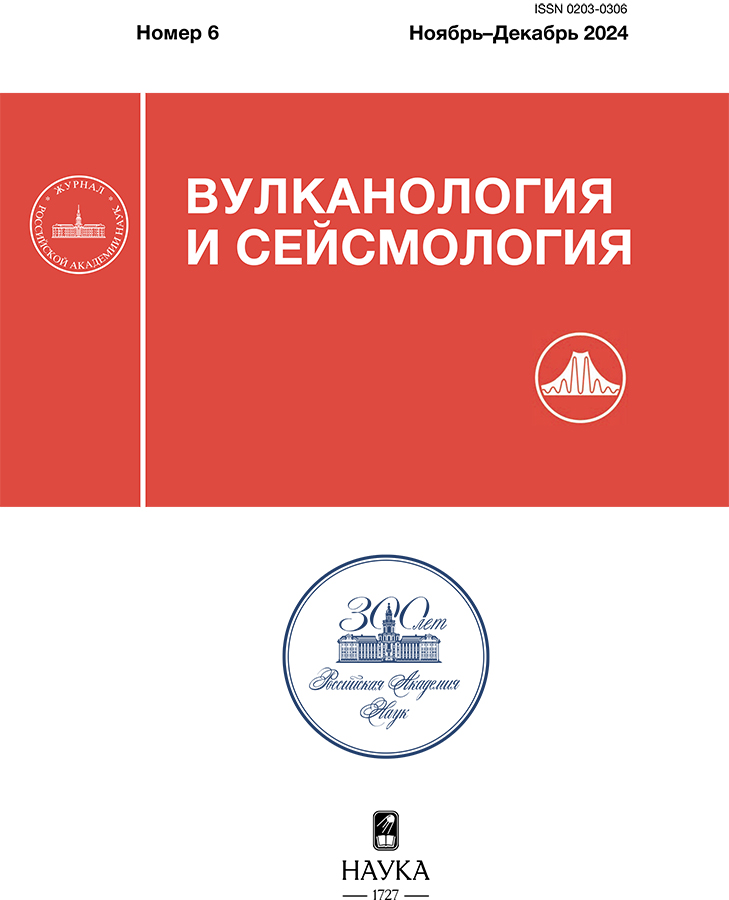Determination of seismic regime parameters for seismic hazard assessment within the territory of the Irkutsk oblast
- Autores: Shebalin P.N.1, Vorobieva I.A.1, Baranov S.V.2,1, Kovalenko A.A.3, Livinskiy A.I.1,3, Lykova A.A.3
-
Afiliações:
- Institute of Earthquake Prediction Theory and Mathematical Geophysics, Russian Academy of Sciences
- FRC UGS RAS
- Russian National Reinsurance Company
- Edição: Nº 6 (2024)
- Páginas: 18-27
- Seção: Articles
- URL: https://journals.eco-vector.com/0203-0306/article/view/685205
- DOI: https://doi.org/10.31857/S0203030624060035
- EDN: https://elibrary.ru/HZEFRG
- ID: 685205
Citar
Texto integral
Resumo
The article considers the problem of determining the parameters of the seismic regime for the territory of the Irkutsk region. To solve this problem, a complete catalog of earthquakes within the studied region with a unified magnitude scale was created for the time period from 1962 to 2021. Determination of seismic regime parameters is an important step for subsequent seismic hazard assessments. The solution of this problem is extremely important for insurance and reinsurance companies, as it makes it possible to use the probabilistic approach in the tasks of earthquake risk assessment, which in turn allows to make the most correct management decisions and ensure the stability of the company’s financial system.
Palavras-chave
Texto integral
Sobre autores
P. Shebalin
Institute of Earthquake Prediction Theory and Mathematical Geophysics, Russian Academy of Sciences
Autor responsável pela correspondência
Email: p.n.shebalin@gmail.com
Rússia, Profsoyuznaya str., 84/32, Moscow, 117997
I. Vorobieva
Institute of Earthquake Prediction Theory and Mathematical Geophysics, Russian Academy of Sciences
Email: p.n.shebalin@gmail.com
Rússia, Profsoyuznaya str., 84/32, Moscow, 117997
S. Baranov
FRC UGS RAS; Institute of Earthquake Prediction Theory and Mathematical Geophysics, Russian Academy of Sciences
Email: p.n.shebalin@gmail.com
Kola Branch (KB) FRC UGS RAS
Rússia, Fersmana str., 14, Apatity, Murmansk region, 184209; Profsoyuznaya str., 84/32, Moscow, 117997A. Kovalenko
Russian National Reinsurance Company
Email: anton.kovalenko@rnrc.ru
Rússia, Gasheka str., 6, Moscow, 125047
A. Livinskiy
Institute of Earthquake Prediction Theory and Mathematical Geophysics, Russian Academy of Sciences; Russian National Reinsurance Company
Email: p.n.shebalin@gmail.com
Rússia, Profsoyuznaya str., 84/32, Moscow, 117997; Gasheka str., 6, Moscow, 125047
A. Lykova
Russian National Reinsurance Company
Email: anton.kovalenko@rnrc.ru
Rússia, Gasheka str., 6, Moscow, 125047
Bibliografia
- Ризниченко Ю.В. Об изучении сейсмического режима //Изв. АН СССР. Геофизика. 1958. № 9. С. 1057–1074.
- Шебалин П.Н., Гвишиани А.Д., Дзебоев Б.А., Скоркина А.А. Почему необходимы новые подходы к оценке сейсмической опасности? // Доклады Российской Академии наук. Науки о Земле. 2022. Т. 507. № 1. С. 91–97.
- Aki K. Maximum likelihood estimate of b in the formula log N = a − bM and its confidence level // Bull. Earthquake Res. Inst. 1965. V. 43. P. 237–239.
- Baiesi M., Paczuski M. Scale-free networks of earthquakes and aftershocks // Phys. Rev. E. 2004. V. 69. 066106.
- Baranov S., Narteau C., Shebalin P. Modeling and prediction of aftershock activity // Surveys in Geophysics. 2022.
- Bender B. Maximum likelihood estimation of b-values for magnitude grouped data // Bulletin of the Seismological Society of America. 1983. V. 73. P. 831–851.
- Cornell C.A. Engineering seismic risk analysis // Bulletin of the Seismological Society of America. 1968. V. 58. Iss. 5. P. 1583–1606.
- Gardner J.K., Knopoff L. Is the sequence of earthquakes in southern California, with aftershocks removed, Poissonian? // Bulletin of the Seismological Society of America. 1974. V. 64. P. 1363–1367.
- Grassberger P., Procaccia I. Measuring the strangeness of strange attractors // Physica D: Nonlinear Phenomena. 1983. V. 9. № 1–2. P. 189–208. doi: 10.1016/0167-2789(83)90298-1.
- Marsan D., Lengliné O. Extending Earthquake’ Reach through Cascading // Science. 2008. V. 319. P. 1076–1079. doi: 10.1126/science.1148783.
- Molchan G.M., Dmitrieva O.E. Aftershock Identification: Methods and New Approaches // Geophysical Journal International. 1992. V. 109. P. 501–516. doi: 10.1111/j.1365-246X.1992.tb00113.x.
- Munich Re, NatCatService. 2016. https://reliefweb.int/sites/reliefweb.int/files/resources/Loss_events_worldwide_1980-2015.pdf
- Reasenberg P. Second-Order Moment of Central California Seismicity, 1969–1982 // Journal of Geophysical Research. 1985. V. 90. P. 5479–5495. doi: 10.1029/JB090iB07p05479.
- Shebalin P.N., Narteau C., Baranov S.V. Earthquake productivity law // Geophysical Journal International. 2020. V. 222. Iss. 2. P. 1264–126913. doi: 10.1093/gji/ggaa252.
- Shebalin P., Baranov S., Vorobieva I. Earthquake Productivity Law in a Wide Magnitude Range // Frontiers in Earth Science. 2022. V. 10. Article 881425. doi: 10.3389/feart.2022.881425.
- Shebalin P.N., Baranov S.V., Vorobieva I.A., Grekov E.M., Krushelnitskii K.V., Skorkina A.A., Selyutskaya O.V. Seismicity Modeling in Tasks of Seismic Hazard Assessment // Doklady Earth Sciences. 2024. V. 515. № 1. P. 514–525. doi: 10.1134/S1028334X23603115, EDN: SNHALD.
- Ulomov V.I. Seismic hazard of Northern Eurasia // Annali di Geofisica. 1999. V. 42. Iss. 6. P. 1023–1038.
- Vorobieva I., Gvishiani A., Dzeboev B., Dzeranov B., Barykina Y., Antipova A. Nearest neighbor method for discriminating aftershocks and duplicates when merging earthquake catalogs // Front. Earth Sci. 2022. V. 10. P. 820277. doi: 10.3389/feart.2022.820277.
- Wesnousky S.G. Crustal deformation processes and the stability of the Gutenberg‐Richter relationship // Bulletin of the Seismological Society of America. 1999. V. 89(4). P. 1131–1137.
- Wells D.L., Coppersmith K.J. New Empirical Relationships among Magnitude, Rupture Length, Rupture width, Rupture Area, and Surface Displacement. // Bulletin of the Seismological Society of America. 1994. V. 84. P. 974–1002.
- Zaliapin I., Ben-Zion Y. Earthquake clusters in southern California I: Identification and stability // J. Geophys. Res. Solid Earth. 2013. V. 118. P. 2847–2864. doi: 10.1002/jgrb.50179.
- Zechar J.D., Gerstenberger M.C., Rhoades D.A. Likelihood-based tests for evaluating space-rate-magnitude forecasts // Bulletin of the Seismological Society of America. 2010. V. 100(3). P. 1184–1195. doi: 10.1785/0120090192.
- Zhuang J., Ogata Y., Vere-Jones D. Stochastic Declustering of Space-Time Earthquake Occurrences // Journal of the American Statistical Association. 2002. V. 97(458). P. 369–380.
Arquivos suplementares

















